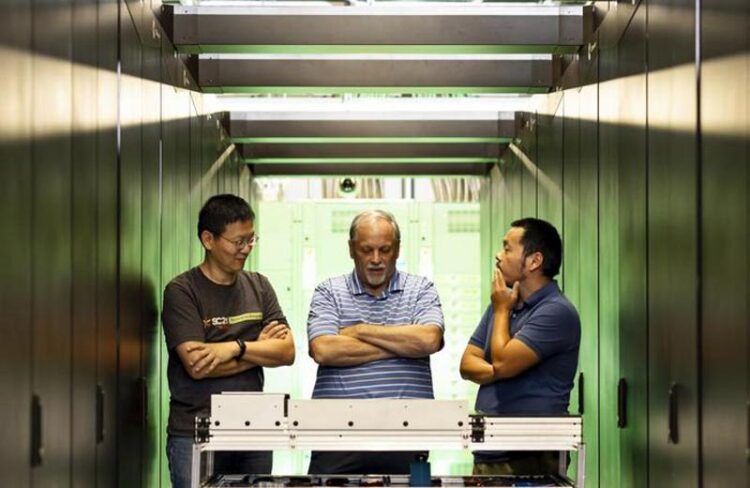Super speeds for super AI

Members of the Analytics and AI Methods at Scale group in the National Center for Computational Sciences at ORNL developed the mixed-precision performance benchmarking tool OpenMxP. From left are group leader Feiyi Wang, technical lead Mike Matheson and research scientist Hao Lu.
Credit: Carlos Jones/ORNL, U.S. Dept. of Energy
Frontier sets new pace for artificial intelligence…
The team that built Frontier set out to break the exascale barrier, but the supercomputer’s record-breaking didn’t stop there.
“The exascale number marks a major milestone itself, but it also marks the beginning of a new chapter in high-speed computing,” said Feiyi Wang, an Oak Ridge National Laboratory computer scientist who leads research into artificial intelligence and analytics. “We don’t have to wait for the next generation of computing anymore. We can have it here today.”
Frontier claimed the title of fastest computer in the world by running at an average speed of more than 1.1 exaflops, or 1.1 quintillion calculations per second. That’s for calculations performed at double precision, a computing standard that relies on 64 bits of memory per calculation for maximum mathematical accuracy.
“Think of the difference between measuring a circle by calculating pi with two decimal places versus 10, 20 or more decimals,” Wang said. “Think of the number of pixels in a photo. The more bits, the more detail captured.”
That level of accuracy comes at the cost of computing speed. But artificial intelligence and machine learning algorithms, which mimic the human brain in learning to recognize patterns over time, typically require less precision — sometimes as little as 32, 24 or even 16 bits. That difference frees Frontier’s processors to run at speeds far beyond exascale.
The capability’s so fresh Wang and his team had to come up with a new kind of test to measure it. The most recent tests clocked Frontier’s mixed-precision speeds at 9.95 exaflops, or 9.95 quintillion calculations per second, almost eight times faster than the double-precision calculations that broke the exascale barrier.
“We didn’t expect this capability,” Wang said. “Think about what we can do with it. Say you want an AI model that can recognize a malignant tumor. The faster the speeds, the more data you can use to train a larger model for more accurate results. We’re approaching the point where we could actually simulate the human brain.”
The roughly 80 million neurons of the human brain operate at an energy level of around a dozen watts — less power than the average light bulb, and an infinitesimal fraction of the 30 megawatts that power Frontier.
“Imagine if we can achieve that level of computing efficiency,” Wang said. “Imagine if we can bridge the gap between human intelligence and machine intelligence. That would be a true breakthrough for humankind. How we bridge that gap will push us toward a better future, for computing and for our lives.”
The Oak Ridge Leadership Computing Facility is a Department of Energy Office of Science user facility located at ORNL.
UT-Battelle manages ORNL for the Department of Energy’s Office of Science, the single largest supporter of basic research in the physical sciences in the United States. The Office of Science is working to address some of the most pressing challenges of our time. For more information, please visit energy.gov/science. – Matt Lakin
Media Contact
Katie Bethea
DOE/Oak Ridge National Laboratory
betheakl@ornl.gov
Office: 757-817-2832
All latest news from the category: Information Technology
Here you can find a summary of innovations in the fields of information and data processing and up-to-date developments on IT equipment and hardware.
This area covers topics such as IT services, IT architectures, IT management and telecommunications.
Newest articles

Detector for continuously monitoring toxic gases
The material could be made as a thin coating to analyze air quality in industrial or home settings over time. Most systems used to detect toxic gases in industrial or…

On the way for an active agent against hepatitis E
In order to infect an organ, viruses need the help of the host cells. “An effective approach is therefore to identify targets in the host that can be manipulated by…

A second chance for new antibiotic agent
Significant attempts 20 years ago… The study focused on the protein peptide deformylase (PDF). Involved in protein maturation processes in cells, PDF is essential for the survival of bacteria. However,…





















